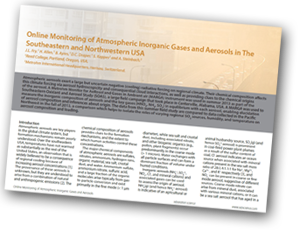Atmospheric aerosols exert a large but uncertain negative (cooling) radiative forcing on regional climate. Their chemical composition affects this climate forcing via aerosol hydroscopicity and consequential cloud interactions, as well as providing clues to the chemical origins of the aerosol. A Metrohm Monitor for AeRosol and Gases in Ambient air (MARGA) instrument was used as part of the Southeastern Oxidant and Aerosol Study (SOAS), a large field campaign that took place in Centerville, Alabama, USA.
Separation Science offers an article download from J.L Fry et al. describing how a Metrohm MARGA was used to measure the inorganic composition of aerosols and the key gases (HNO3, NH3, SO2) in equilibrium with each aerosol, enabling elucidation of aerosol composition and inferences about origin. The data from this field study are compared to data collected in the Pacific Northwest, a comparison which helps to isolate the roles of varying regional SO2 sources, humidity, and temperature on aerosol composition and loading.
 Atmospheric aerosols are key players in the global climate system, but formation mechanisms remain poorly understood. Over the southeastern USA, temperatures have not warmed as substantially as the rest of the United States, an observation that is widely believed to be a consequence of regional cooling because of increasing aerosol concentrations. The provenance of these aerosols is unknown, but they are understood to arise from a combination of natural and anthropogenic emissions. The chemical composition of aerosols provides clues to the formation mechanisms, and the extent to which human activities control these concentrations.
Atmospheric aerosols are key players in the global climate system, but formation mechanisms remain poorly understood. Over the southeastern USA, temperatures have not warmed as substantially as the rest of the United States, an observation that is widely believed to be a consequence of regional cooling because of increasing aerosol concentrations. The provenance of these aerosols is unknown, but they are understood to arise from a combination of natural and anthropogenic emissions. The chemical composition of aerosols provides clues to the formation mechanisms, and the extent to which human activities control these concentrations.
The major chemical components of atmospheric aerosols are sulfates, nitrates, ammonium, hydrogen ions, organic material, sea salt, crustal dust, and water. Ammonium sulfate, ammonium nitrate, sulfuric acid, and a large fraction of the organic molecules arise typically from gasto- particle conversion and exist primarily in the fine mode (< 1 μm diameter), while sea salt and crustal dust, including associated nitrate, and other biogenic organics (e.g., pollen, plant fragments) occur predominantly in the coarse mode (> 1 micron). Water exchanges with all particle surfaces and can form a dominant fraction of volume under humid conditions.
Inorganic aerosols (NH4+, SO42-, NO3-, Cl-, and mineral cations) and associated gases can be used to assess the origin of aerosol. NH3(g) (and hence NH4+ aerosol) is indicative of an agricultural or animal husbandry source, SO2(g) (and hence SO42- aerosol) is prominent in coal-fired power plant plumes as a result of the sulfur content of coal, Cl- aerosol indicates an ocean source when associated with mineral cations present in the sea salt mass ratio of 28:3.4:1.1:1 for Na+, Mg2+, Ca2+, and K+ respectively, and NO3- can be present in coarse or fine mode aerosol, suggestive of different sources. Coarse mode nitrate can arise from mineral dust, associated with various mineral cations, or it can be a sea salt aerosol that has aged in a plume containing NOx, displacing Cl- with NO3-; fine-mode NO3-, typically present as NH4NO3, indicates NOx and its oxidation product HNO3 have been involved in the upwind chemistry. NOx and HNO3 are indicative of combustion sources, including stationary power plant sources and vehicle mobile sources, which are widely spread in any populous area.
The interpretation of aerosol inorganic nitrate is the most complex among inorganic ions, and the complementary cation measurements made in this study are essential to our interpretation. The origins of nitrate can best be interpreted with the aid of size distribution data and an assessment of counter-cations: NO3- in the sub‑μm aerosol is most likely secondary NH4NO3, which can be confirmed by measuring the cation/anion balance to ascertain that excess NH4+ exists after all SO42- has been neutralized. In contrast, coarse-mode NO3- (some of which can extend below 1 μm diameter) associated with Na+ dominant cations is likely to be aged sea salt, while Ca2+ dominance among cations is suggestive of nitrate-aged mineral dust.
